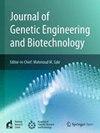胃癌的预后生物标志物和治疗靶点
IF 2.8
Q3 Biochemistry, Genetics and Molecular Biology
Journal of Genetic Engineering and Biotechnology
Pub Date : 2025-05-07
DOI:10.1016/j.jgeb.2025.100504
引用次数: 0
摘要
胃癌是世界上最常见的恶性肿瘤之一,具有复杂的病因和病理机制。关于生物钟基因失调的新证据为改善胃癌患者的诊断、治疗和预后提供了有希望的机会。方法:采用机器学习算法、基因集富集分析、免疫浸润谱分析、生存预后分析、药敏试验和体外实验等多角度研究核心时钟基因在GC中的功能作用。结果:通过整合来自The Cancer Genome Atlas、Gene Expression Omnibus数据集和National Center for Biotechnology Information数据库的数据,我们确定了29个GC中差异表达的时钟基因。其中,四种不同的机器学习算法的应用突出了TIMELESS (TIM)和BHLHE41作为关键基因,TIM表现出显著的诊断性能(受试者工作特征曲线下面积= 0.802)。TIM表达升高与临床预后差和肿瘤组织免疫细胞浸润增加密切相关。值得注意的是,TIM与焦热相关分子CASP8之间存在特异性相互作用,表明其在GC发病机制中具有潜在的协同作用。此外,硼替佐米成为一种潜在的靶向治疗剂,能够调节GC中的TIM活性。结论:TIM是一种有前景的GC诊断生物标志物和治疗靶点,对改善患者预后和指导个性化治疗策略具有重要意义。本文章由计算机程序翻译,如有差异,请以英文原文为准。
TIMELESS as a prognostic biomarker and therapeutic target in gastric cancer
Background
Gastric cancer (GC), one of the most prevalent malignancies worldwide, is characterized by complex etiological and pathological mechanisms. Emerging evidence on the dysregulation of circadian clock genes has revealed promising opportunities for improving the diagnosis, treatment, and prognosis of patients with GC. Methods: This study utilized a multifaceted approach combining machine learning algorithms, gene set enrichment analysis, immune infiltration profiling, survival prognosis analysis, drug sensitivity testing, and in vitro experiments to investigate the functional roles of core clock genes in GC. Results: By integrating data from The Cancer Genome Atlas, Gene Expression Omnibus datasets, and the National Center for Biotechnology Information database, we identified 29 differentially expressed clock genes in GC. Among these, the application of four distinct machine learning algorithms highlighted TIMELESS (TIM) and BHLHE41 as pivotal genes, with TIM demonstrating notable diagnostic performance (area under the receiver operating characteristic curve = 0.802). Elevated TIM expression was strongly associated with poor clinical prognosis and increased infiltration of immune cells in tumor tissues. Notably, a specific interaction was identified between TIM and the pyroptosis-associated molecule CASP8, indicating a potential synergistic role in GC pathogenesis. Additionally, bortezomib emerged as a potential targeted therapeutic agent capable of modulating TIM activity in GC. Conclusion: TIM is identified as a promising diagnostic biomarker and therapeutic target in GC, offering valuable implications for improving patient prognosis and guiding personalized treatment strategies.
求助全文
通过发布文献求助,成功后即可免费获取论文全文。
去求助
来源期刊

Journal of Genetic Engineering and Biotechnology
Biochemistry, Genetics and Molecular Biology-Biotechnology
CiteScore
5.70
自引率
5.70%
发文量
159
审稿时长
16 weeks
期刊介绍:
Journal of genetic engineering and biotechnology is devoted to rapid publication of full-length research papers that leads to significant contribution in advancing knowledge in genetic engineering and biotechnology and provide novel perspectives in this research area. JGEB includes all major themes related to genetic engineering and recombinant DNA. The area of interest of JGEB includes but not restricted to: •Plant genetics •Animal genetics •Bacterial enzymes •Agricultural Biotechnology, •Biochemistry, •Biophysics, •Bioinformatics, •Environmental Biotechnology, •Industrial Biotechnology, •Microbial biotechnology, •Medical Biotechnology, •Bioenergy, Biosafety, •Biosecurity, •Bioethics, •GMOS, •Genomic, •Proteomic JGEB accepts
 求助内容:
求助内容: 应助结果提醒方式:
应助结果提醒方式:


